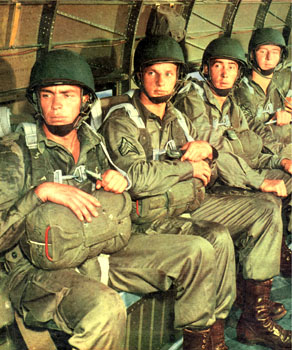The three major airborne forces of WWII used chutes that were superficially similar in that they all had 28ft diameter canopies. In their detail operation they were quite different however.
The US Airborne’s first attempt was the T4. A workmanlike job, the rig featured a reserve (emergency) ‘chute which was carried vertically on the trooper’s chest leaving little room for other equipment. Like all the parachutes for assault troops, it relied on a static line to open the main canopy once the soldier dropped clear of the aircraft (the reserve of course was manually operated). The T4 was superseded by the T5 by the time of the first operational jumps. The principal observable difference was the horizontal stowage of the reserve ‘chute. (The Americans were the only combatants to use a reserve. With typical British phlegm their decision not to was originally based on the small size of the ‘hole in the floor’ exit on a Whitley, and later on cost. The Germans jumped from much lower altitude with a rig that in any case made a reserve impracticable.)
Both the American designs suffered from not having a single point quick-release (it was felt that troopers might fall out of the harness too easily). This, however, meant that getting out of the harness on the ground could be a struggle, taking up precious seconds and making the trooper vulnerable. This latter point was addressed by the T7 (first issued in 1944) which did have a quick-release.
A more serious complaint was that all three US parachutes had the canopy opening first, before all the rigging deployed. This resulted in the wearer going from 120mph to almost zero in a few feet as the canopy ‘stopped’ to deploy whilst the shroud lines paid out and then snapped the falling trooper to a halt. Such was the violence of this arrested motion that in Normandy some troopers found that grenades in their pockets simply burst through the seams and were lost.
The Germans also had a ‘canopy first’ ‘chute, the RZ 20, which was even more demanding of the trooper. Unlike the British and American rigs in which the canopy lines were gathered into four risers, the Germans had a single point suspension which met an inverted V-strop attached to rings either side of the jumper’s waist (inexplicably, as their standard aircrew parachutes were entirely conventional). This meant that the Fallschirmjaeger had no control over direction or rate of descent. Worse, when the canopy snapped open he would jackknife due to being suspended from the waist. This arrangement resulted in a ‘face forward’ landing attitude. The one tactical advantage of the RZ 20 was its ability to cope with very low altitude drops. In Crete some sticks went out as low as 250 feet.
The British X-Type parachute on the other hand had none of the vices suffered by its contemporaries. Like the American T-Series it had four risers and the incumbent rode down in an almost sitting posture. Like the American rig the ability to ‘spill’ air from the canopy by pulling on the risers gave a measure of control, enabling the jumper to turn into wind for landing and to a certain extent steer away from obstacles (not that there was much time for such niceties at 500 feet in the dark). The X-Type also featured the classic ‘turn and strike’ quick-release, which made getting out of the harness a simple operation, saving vital seconds after landing.
Its most important feature, unlike the others, was a ‘canopy last’ deployment. Essentially the static line pulled the canopy out of the pack in a bag or sheath. The shroud lines then paid out evenly until they pulled the canopy out of its bag. The deceleration for the paratrooper was thus more even as the canopy developed. The downside was that it was therefore slower-opening than the German or American models, and less able to cope with low altitude drops. It was nevertheless acknowledged as the most reliable of all the parachutes used during the conflict.
